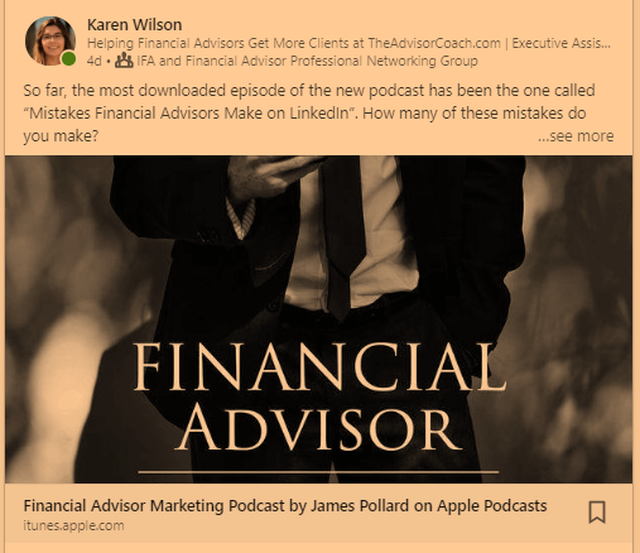7 Awesome Content Marketing Tips for Financial ServicesNOTE: If you’re a new financial advisor, make sure you check out Your First Year As A Financial Advisor, where I reveal several things every new financial advisor ought to know.
Content is king.
As a financial services professional, you’ve probably heard that phrase before. But what is the exact role of content in the success of financial firms… and how can financial services firms improve their existing content marketing? Let’s dive in… What Is Content Marketing?Content marketing is a type of inbound marketing strategy in which businesses develop content that is relevant and useful to their target audience with the following goals in mind:
You don’t use content marketing to directly pitch your financial services. Instead, you focus on what pain points your prospects are suffering and aim to solve these pain points via genuinely helpful content. The blog post you’re reading right now is a form of content marketing - its goal is to help you understand the benefits of content marketing and provide you with actionable tips. ALSO READ: 5 Online Reputation Management Tips for Financial Advisors The Stats Say It All...So why do financial firms like Citigroup and FICO - among others - choose to make content marketing a key part of their strategy?
However, many financial services professionals still struggle with using content marketing to its full potential. For instance, 52% struggle with reaching the right audience, which probably means they don't have a specific niche. Additionally, 44% can't keep up with their competition - the market for financial services is a cutthroat one, and those who don’t use content marketing effectively will get overtaken by those who do. ALSO READ: Why Most Financial Advisor Sales Training Utterly Fails Types of Content Marketing For Financial Services ProfessionalsIf you’re part of the group who is still lagging behind for content marketing, here’s the type of content you should be focusing on for the best results in the financial services industry...
Blog PostsPublishing blog posts on a regular basis is one of the most popular and effective ways to generate leads and nurture your target clientele.
Why are blog posts so effective?
In case of doubt, I suggest starting with blogging and developing your content marketing strategy from there - especially if you’re starting off with a small budget. I’ve found blog posts to be especially helpful if you can specialize in writing content about a specific topic or for a particular niche. Plus, it never hurts to get input from your clients and prospects about what they want to read about on your blog. I’ve produced dozens and dozens of articles for the blog here at The Advisor Coach and it’s been one of my most effective marketing strategies. I take pride in teaching financial firms how to do the same. Social Media PostsIf you’re a financial services professional without a social media presence, chances are you’re falling behind on your competition.
It’s one of the easiest and most effective methods of building an audience as well as engaging with that audience on a regular basis to nurture prospects. You can use platforms such as Facebook, Twitter, and Pinterest to share the following type of content:
I’ve also found repurposing content to be amazingly effective when used on social media. For example, if I send an email to my list which gets a lot of engagement, I will also post it on social media. I will also share my podcast episodes on social media, which leads to more listeners and subscribers. Speaking of podcasts… ALSO READ: More Social Media Tips PodcastsPodcasts are just so easy to consume - many people make podcasts a daily part of their content consumption due to its passive nature.
They’re the perfect platform to showcase interviews with financial industry experts to provide valuable information outside of your own perspective. Plus, associating yourself with other experts helps to position your organization as an expert as well. I’ve been fortunate enough to host two podcasts - my old “The Advisor Coach” podcast (which is no longer live) and my “FA Marketing” podcast. I can tell you from firsthand experience that producing and promoting a podcast is hard work but it’s well worth it. Podcasts work even better if you can commit to a regular schedule. For example, my podcast has new episodes uploaded every Monday, which means my personal target market can spend 15-30 minutes with me every single week. This builds a strong bond between me and my audience. VideosVideo is the name of the game in 2019.
Since video enables financial marketers to communicate complex ideas via a dynamic visual medium, it’s one of the best converting types of content. In fact, 71% of marketers state that video content is more conversion friendly than other content - websites using video content have an average conversion rate of 4.8% compared to 2.9% for those who don’t. I’ve found video marketing for financial services to be especially effective when explaining complex topics to your market. For example, people may not want to read an article about the differences between a traditional IRA and a Roth IRA but they don’t mind watching a video about it. E-Books & White PapersE-books are similar to blog posts, but are typically longer and available via download. White papers differ by providing 100% data-driven information that helps prospects understand an issue and position your services as an obvious solution.
Both white papers and e-books can be used as opt-in incentives to collect your prospects’ email addresses. (Plus, I can proudly say that I can go into almost any business and improve their email marketing - it’s one of my superpowers.) White papers can especially help you build thought leadership in the financial industry while simultaneously help you gain information about your leads, since 76% of buyers are willing to give you their information in exchange for the helpful data found in a white paper. Content Marketing TipsSo you’ve got a good idea of the type of content worth producing for financial services.
But you can’t just start pumping out mediocre content and expect results. Below are the best ways to ensure your content marketing has the best ROI. 1. Develop Relevant ContentThe content you create should always be relevant and interesting for the specific audience you’re targeting.
Trying to make your content relevant to everyone won’t work - it will just water down its relevance for everyone. And this is true for the entirety of the content - you should definitely avoid using clickbaity headlines that sound relevant, but that lead to irrelevant content. Content that is irrelevant to your audience won’t get consumed, and thus won’t provide you with the benefits of content marketing. On the other hand, relevant content will engage your audience and ensure they don’t get bored. This means they’ll be looking forward to consuming more of your content - and learn to trust you and want to do business with you. So, what is ‘relevant’ content, exactly?
For instance, if you’re targeting baby boomers on the verge of retirement, you shouldn’t be sharing edgy memes relevant to millennials on your Twitter. They won’t connect with that type of humor and will be more likely to unfollow you. In fact, I'm practicing what I preach right now because I'm creating content for financial services professionals... my target market. :-) 2. Target Specific KeywordsEach piece of content you publish - especially videos and blog posts - should be optimized for a specific keyword.
However, avoid keyword stuffing, as this makes your content stilted and unnatural - anyway, this technique no longer works and will penalize you on search engine rankings. Instead, focus on addressing the searcher intent for your keyword in a genuinely helpful way. For instance, you should include the answers to the questions that pop up in the ‘People Also Ask’ section on Google: If you want to rank for the keyword ‘How to plan for retirement’, your content should definitely answer the questions shown above. This will tell Google that your content addresses frequent questions, thus making it a valuable resource that should rank higher.
Also, one of the biggest “quick wins” I can give you when it comes to content marketing for financial services firms is to optimize around your geographic region. This means if you’re an accountant from Boise, Idaho, you probably want to optimize your site for “Accountant in Boise, Idaho”. It seems simple but you would be amazed at how many people don’t do it. ALSO READ: 3 Things You Must Know About SEO 3. Create Longer ContentMany organizations shy away from publishing long content because:
But that’s simply not true. On average, top ranking blog posts have at least 1890 words, meaning it will drive more traffic than short posts. So, which is more of a waste of money - spending $50 on a 500-word blog post that no one will read, or $200 on a blog post that will drive traffic and engage your prospects? If your content is relevant and engaging, your audience will not get bored. One of the biggest myths in marketing involves creating long copy for websites and businesses. Many times, business owners think, “My prospects won’t read all that”, which prevents them from creating long enough content to “sell” the prospects on setting an appointment or doing business with them. Plus, if you’re going to share your content on social media, I’ve noticed that longer content gets shared more often, on average, than short content. 4. Repurpose Your ContentI mentioned this earlier in the article but it’s an extremely important point. You’re spending so much money on quality content - why not repurpose it to stretch that ROI?
For example:
If you have a piece of content that is performing well in one area, there’s a good chance it will perform well in other areas too. In addition, repurposing content helps you reach new audience members. In my own case, different people follow me on social media and listen to my podcast - by sharing my podcast on social media, I am reaching more people. 5. Use Conversational LanguageOne of the biggest problems in the financial services industry is the use of complicated financial jargon.
This doesn’t make your content better - it just makes it more complicated for people to understand. Notice the type of language I’m using in this blog post. I don’t shy away from contractions and I avoid any type of jargon. Those who keep things simple tend to have a huge edge over those who publish strictly technical content. 6. Develop Your Own Unique VoiceAs a financial services professional, you have something unique - your own expertise and point of view.
One of the biggest mistakes you could make is to copy your competition’s content instead of leveraging your own voice. Stand out from the crowd by making your content unique - for instance, you could use personal stories and provide tips that you have used yourself instead of writing about what other firms are doing. 7. Conclude With a Call to ActionThis is the key to creating content that converts.
Always end your content with an actionable next step for your prospect. You’ll notice that I end most of my blog posts by asking readers for their email addresses. From there, you can personally reach out to your prospects via email to schedule an appointment via scheduling tools such as Calendly or Acuity. You can also continue to nurture your email list by sending out more relevant content on a regular basis until they are ready to do business with you. ALSO READ: 19 Email Marketing Tips Wrapping UpFor financial services professionals who want to skyrocket their revenue, content marketing is definitely the way to go.
Failing to take up content marketing is a surefire way to fall behind and lose potential clients to your competitors. ALSO READ: More Content Marketing Tips |




